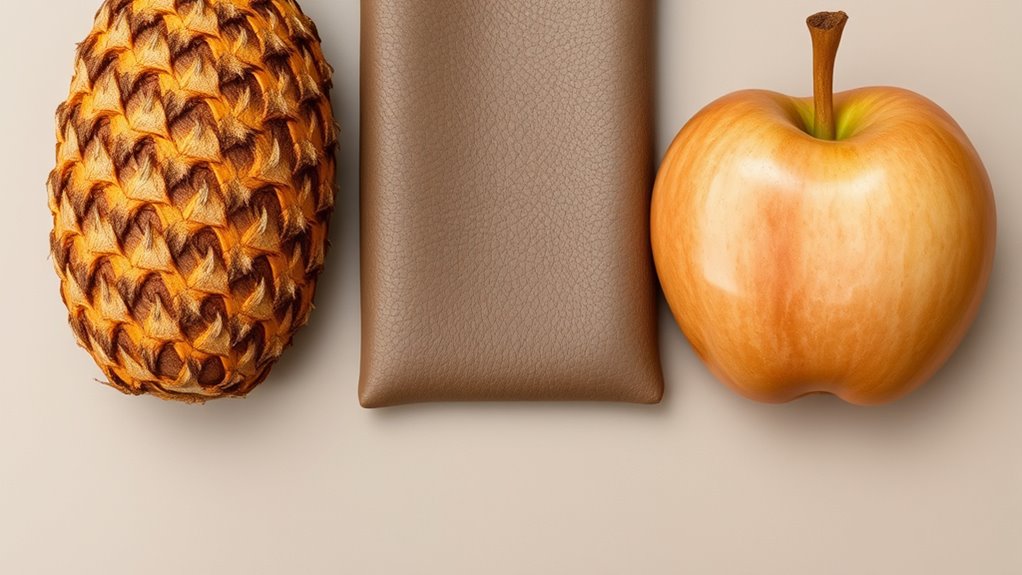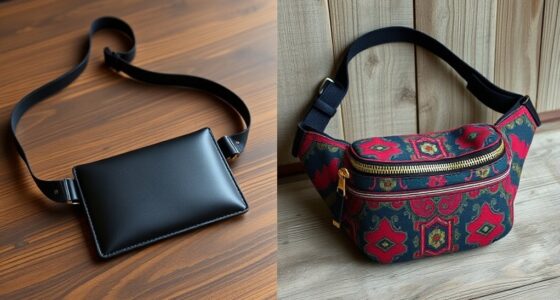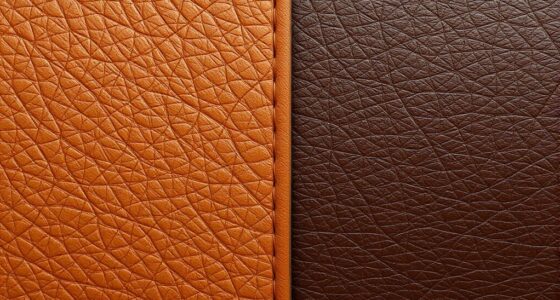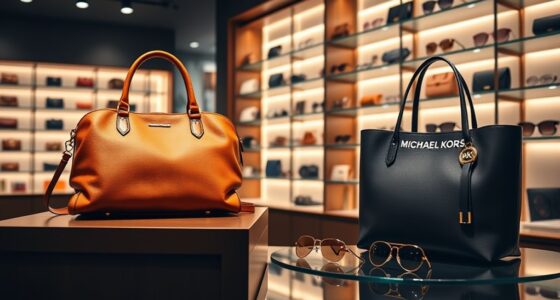When comparing vegan leathers like Pinatex, mushroom leather, and apple leather, you’ll find each offers eco-friendly alternatives to traditional materials. Pinatex uses pineapple leaf fibers, reducing agricultural waste, while mushroom leather is made from fungi, requiring minimal resources. Apple leather repurposes food industry waste, supporting circular economies. All three materials focus on sustainable sourcing and low-impact manufacturing. If you’re interested in how these options stack up environmentally and ethically, continue exploring to discover more about their unique benefits.
Key Takeaways
- Pinatex is made from pineapple leaf fibers, emphasizing agricultural waste reuse and minimal chemical use.
- Mushroom leather is derived from fungi, offering a low-impact, fast-growing, and highly sustainable alternative.
- Apple leather utilizes apple processing waste, promoting circular economy principles and waste reduction.
- All three materials prioritize eco-friendly manufacturing processes, avoiding toxic chemicals and conserving water.
- They cater to eco-conscious consumers seeking durable, stylish, and ethically responsible vegan leather options.

Vegan leather has gained popularity as a sustainable alternative to traditional animal-derived materials, offering a variety of options for eco-conscious consumers. When exploring different types of vegan leather, it’s important to consider how they are produced, especially focusing on sustainable sourcing and eco-friendly manufacturing processes. These factors determine not only the environmental impact but also the quality and durability of the material you choose.
Take Pinatex, for example. Made from pineapple leaf fibers, it utilizes agricultural waste that would otherwise be discarded. This makes Pinatex an excellent choice for sustainable sourcing, as it leverages a byproduct of the pineapple harvest, reducing waste and promoting resource efficiency. The manufacturing process for Pinatex is designed to be eco friendly, avoiding toxic chemicals and minimizing water usage. By choosing Pinatex, you support a supply chain that values environmental responsibility and reduces reliance on synthetic plastics. Its production emphasizes transparency and sustainability, appealing to consumers who want to lessen their carbon footprint.
Pinatex utilizes pineapple leaf fibers, reducing waste and promoting sustainable, eco-friendly production practices.
Mushroom leather, often called mycelium leather, is another innovative vegan option. It’s created from the root-like structures of fungi, which are cultivated in controlled environments. The sustainable sourcing of mushroom leather relies on fast-growing fungi that require minimal land and water, making it a highly eco-friendly alternative. The manufacturing process for mushroom leather typically involves fermenting the fungi, which is a low-impact, chemical-free process that emphasizes eco friendly manufacturing methods. It can be produced quickly and with fewer resources compared to traditional leather, making it a sustainable choice for those seeking environmentally responsible products. Plus, mushroom leather can be textured and colored in various ways, offering versatility without sacrificing sustainability. Additionally, the growth process of fungi can be optimized to further reduce environmental impact, aligning with principles of circular economy.
Apple leather, derived from apple peels and cores, exemplifies circular economy principles. It uses waste from apple processing, turning what would be discarded into a valuable material. This approach highlights sustainable sourcing by repurposing food industry byproducts. The manufacturing process for apple leather is carefully designed to be eco friendly, incorporating non-toxic adhesives and dyes. It minimizes water and energy consumption, aligning with eco-conscious values. Apple leather provides a stylish, durable alternative that supports waste reduction and sustainable production practices. Its innovative use of fruit waste demonstrates how eco friendly manufacturing can transform agricultural leftovers into high-quality, eco-conscious products.
In choosing between Pinatex, mushroom leather, and apple leather, you’re not just selecting a material—you’re endorsing a more sustainable, ethical approach to fashion. Each type represents a different method of sustainable sourcing and eco friendly manufacturing, allowing you to make a conscious decision that aligns with your environmental values.
Frequently Asked Questions
How Eco-Friendly Are These Vegan Leathers Compared to Traditional Leather?
You’ll find that these vegan leathers generally have a lower environmental impact than traditional leather, primarily because they use fewer resources and avoid animal farming. Pinatex, mushroom, and apple leather all promote resource sustainability by utilizing agricultural waste or innovative materials. While they aren’t completely eco-friendly, they markedly reduce pollution and water use, making them a more sustainable choice for environmentally conscious consumers like you looking to lessen their ecological footprint.
What Are the Main Durability Differences Among Pinatex, Mushroom, and Apple Leather?
Imagine the durability comparison among Pinatex, mushroom, and apple leather as if it’s a quest for the strongest armor. Pinatex offers good material strength but may be less durable than traditional leather. Mushroom leather tends to be more resilient, resisting wear over time. Apple leather, while stylish, might not last as long under heavy use. You’ll find mushroom leather generally provides the best durability, making it ideal for long-lasting products.
Can These Vegan Leathers Be Recycled or Composted After Use?
You can’t easily recycle or compost these vegan leathers due to biodegradability challenges and limited recycling processes. Pinatex, mushroom, and apple leather aren’t biodegradable in typical composting environments, and their manufacturing often involves plastics or chemicals that hinder recycling. While some brands explore eco-friendly disposal options, currently, you’ll need to contemplate responsible waste management and seek specialized recycling programs if available, as standard composting or recycling isn’t effective.
Which Vegan Leather Type Is Most Suitable for Clothing Versus Accessories?
Like a chameleon adapting to its surroundings, you’ll find mushroom leather best for clothing, offering comfort and flexibility needed for daily wear. Pinatex and apple leather excel in accessories, thanks to their durability and style adaptability. For dynamic fashion choices, mushroom leather provides a natural, breathable option, while the others add a sophisticated touch. Ultimately, your wardrobe’s versatility depends on selecting the vegan leather that aligns with your lifestyle and aesthetic.
Are There Any Health Concerns Related to Chemical Treatments in These Materials?
You should be aware that chemical treatments in vegan leathers can raise concerns about chemical safety and potential allergic reactions. These materials often undergo processes with adhesives, dyes, or finishes that might cause sensitivities. To minimize risks, look for brands that prioritize non-toxic, eco-friendly treatments. Always check product labels and test a small skin area first to guarantee you won’t experience allergic reactions.
Conclusion
So, as you explore the enticing world of vegan leathers, remember Pinatex’s playful pineapple, mushroom’s marvelous malleability, and apple’s alluring appeal. Each offers unique qualities, so your choice depends on your style, sustainability, and sensibility. By balancing beauty with responsibility, you’ll boldly build a better, more sustainable wardrobe. Embrace the eco-friendly elegance, and let your fashionable flair flourish with these fabulous, forward-thinking leather alternatives. Your conscious closet awaits your creative, caring choice!









